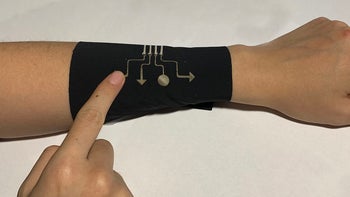Forget smartwatches, breathable smart fabrics might be the future

Wearable gadgets are limited to smartwatches and fitness bands nowadays, but there are far more exciting concepts in the pipeline. Researchers from North Carolina State University have demonstrated an ultrathin breathable smart armband, that was able to control a game of Tetris.
The team used a simple technique to create the prototype. Scientists first stretched a polymer to a thin film filled with nanoholes to make it breathable. The next step was to dip the material in a silver solution, and then researchers used heat to etch touch-sensitive electrodes in the armband. The final result is an ultra-thin and breathable human-machine interface. Check out the demonstration in the video below.

“The end result is extremely thin – only a few micrometers thick. This allows for better contact with the skin, giving the electronics a better signal-to-noise ratio. And gas permeability of wearable electronics is important for more than just comfort,” says Shanshan Yao, co-author of the paper and a former postdoctoral researcher at NC State in a press release.
There are multiple potential applications of this technology. You can turn parts of your clothing into ECG sensors that can measure your performance during fitness activities. Think of a T-shirt with an embedded heart rate sensor in the chest area. Much more precise than wrist alternatives and also breathable so that you can sweat away this winter belly of yours freely.
The team used a simple technique to create the prototype. Scientists first stretched a polymer to a thin film filled with nanoholes to make it breathable. The next step was to dip the material in a silver solution, and then researchers used heat to etch touch-sensitive electrodes in the armband. The final result is an ultra-thin and breathable human-machine interface. Check out the demonstration in the video below.

“The end result is extremely thin – only a few micrometers thick. This allows for better contact with the skin, giving the electronics a better signal-to-noise ratio. And gas permeability of wearable electronics is important for more than just comfort,” says Shanshan Yao, co-author of the paper and a former postdoctoral researcher at NC State in a press release.
There are multiple potential applications of this technology. You can turn parts of your clothing into ECG sensors that can measure your performance during fitness activities. Think of a T-shirt with an embedded heart rate sensor in the chest area. Much more precise than wrist alternatives and also breathable so that you can sweat away this winter belly of yours freely.
Smart fabrics could be used to control your smartphone remotely, too - skip a song, make a selfie, answer or reject a call, etc. Maybe someday, e-textile will render smartwatches and other similar devices obsolete, who knows? So, enjoy your Apple Watch while it lasts and brace yourselves for the iShirts and iShotrs of tomorrow.










Things that are NOT allowed: